
The Willandra National Park is a protected national park that is located in the Far West region of New South Wales, in eastern Australia. The 19,386-hectare (47,900-acre) national park is situated approximately 580 kilometres (360 mi) west of Sydney and comprises flat grassy plain bounded to the north by Willandra Creek, which is a tributary of the Lachlan River.
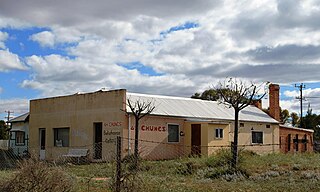
Menindee is a small town in the far west of New South Wales, Australia, in Central Darling Shire, on the banks of the Darling River, with a sign-posted population of 980 and a 2016 census population of 551. Menindee was the first town to be established on the Darling River. There are two distinct theories for the derivation of the township’s name: (a) from the Barkindji word "minandichi" for the shallow ephemeral lake north-west of the present-day township; (b) from the Barkindji word 'milhthaka', meaning "yolk of an egg".

Sheep shearing is the process by which the woollen fleece of a sheep is cut off. The person who removes the sheep's wool is called a shearer. Typically each adult sheep is shorn once each year. The annual shearing most often occurs in a shearing shed, a facility especially designed to process often hundreds and sometimes more than 3,000 sheep per day.

The Willandra Lakes Region is a World Heritage Site in the Far West region of New South Wales, Australia. The Willandra Lakes Region is the traditional meeting place of the Muthi Muthi, Nyiampaar and Barkinji Aboriginal tribes. The 240,000-hectare (590,000-acre) area was inscribed on the World Heritage List at the 5th Session of the World Heritage Committee in 1981.

The Golden Fleece, originally known as Shearing at Newstead, is an 1894 painting by the Australian artist Tom Roberts. The painting depicts sheep shearers plying their trade in a timber shearing shed at Newstead North, a sheep station near Inverell on the Northern Tablelands of New South Wales. The same shed is depicted in another of Roberts' works, Shearing Shed, Newstead (1894).
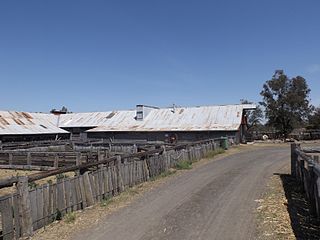
Jondaryan Woolshed is a heritage-listed shearing shed at Evanslea Road, Jondaryan, Queensland, Australia. It was built in 1859-60 to replace an earlier, smaller woolshed on the former Jondaryan pastoral station, which was at one stage the largest freehold station in Queensland. The woolshed was the scene of significant labour conflict in the late 1880s and early 1890s, as the station became a test case for the new Queensland Shearers Union in the lead-up to the 1891 Australian shearers' strike.
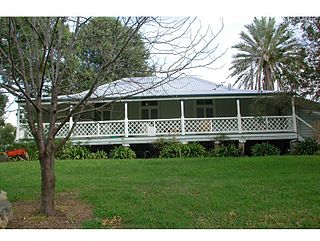
Jondaryan Homestead is a heritage-listed homestead at Evanslea Road, Jondaryan, Toowoomba Region, Queensland, Australia. It was the base of the former Jondaryan pastoral station, which was originally taken up in 1840, and at one time was the largest freehold station in Queensland. The site contains the current house, which was built after the original was destroyed by fire in 1937, the original kitchen dating from 1844, and a kitchen, butcher's shop, shearer's quarters, stables, dairy, toilet block and store, many dating from the 1860s. It also contains the remains of horse stalls, a slaughterhouse, hide store, and Chinese gardener's glasshouse. It was added to the Queensland Heritage Register on 21 October 1992.

Nindooinbah Homestead is a heritage-listed homestead at Nindooinbah Connection Road, Nindooinbah, Scenic Rim Region, Queensland, Australia. It was built from c. 1858 to 1907. It is also known as Nindooinbah House. It was added to the Queensland Heritage Register on 21 October 1992.

Ballandean Homestead is a heritage-listed homestead at Ballandean, Southern Downs Region, Queensland, Australia. It was built from c. 1840 to 1890s circa. It was added to the Queensland Heritage Register on 21 October 1992.

Beaconsfield Station Sheep Wash is a heritage-listed sheep washing facility at Beaconsfield Station, Ilfracombe, Longreach Region, Queensland, Australia. It was built in 1890s. It is also known as Beaconsfield Station Sheep Wash (Ruins). It was added to the Queensland Heritage Register on 21 October 1992.

Isis Downs Woolshed is a heritage-listed shearing shed at Isisford-Blackall Road, Isisford, Longreach Region, Queensland, Australia. It was designed by Kay, MacNicol and Company Engineers and built from 1913 to 1914 by Dorman Long and Company (Melbourne). It was added to the Queensland Heritage Register on 18 September 2008.
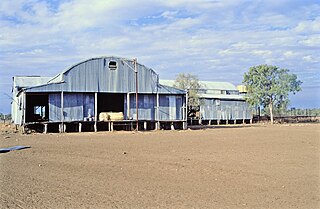
Darr River Downs is a heritage-listed homestead at Landsborough Highway, Morella, Longreach Region, Queensland, Australia. It was built from 1870s circa to 1900s circa. It was added to the Queensland Heritage Register on 27 June 2003.
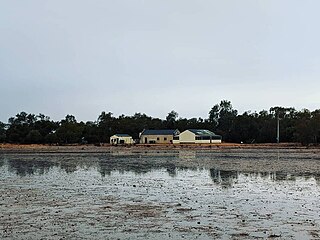
The Mount Wood Station, also known as simply Mt Wood, is a heritage-listed former cattle station that now forms part of the Sturt National Park in Tibooburra in the Unincorporated Far West region of New South Wales, Australia. The cattle station was built between 1890 and 1969. As a national park, the property is owned by the NSW Officer of Environment and Heritage, an agency of the Government of New South Wales. It was added to the New South Wales State Heritage Register on 2 April 1999.

The Avoca Homestead Complex is a heritage-listed former station homestead and station facilities and now catered accommodation and visitor attraction at 1122a Low Darling Road, Wentworth, in the Wentworth Shire, New South Wales, Australia. It was built between 1871 and 1879. It is also known as the Avoca Station Homestead and outbuildings. It was added to the New South Wales State Heritage Register on 8 April 2016.
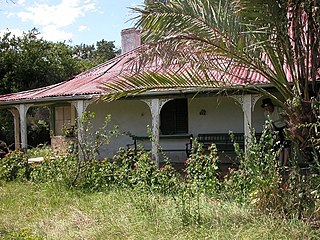
Cliefden is a heritage-listed homestead at 1521 Belubula Way, Mandurama, Blayney Shire, New South Wales, Australia. It is one of a group of historic sites labelled the Ben Hall Sites for their association with bushranger Ben Hall, along with Ben Hall's Death Site, the Bushranger Hotel, Escort Rock, the Grave of Ben Hall and Wandi. It was built from 1842. It was added to the New South Wales State Heritage Register on 8 October 2010.

Old Errowanbang Woolshed is a heritage-listed shearing shed at Errowan Park, Old Errowanbang Lane, Errowanbang, Blayney Shire, New South Wales, Australia. It was designed by Watt and built in 1886. It is also known as Errowanbang Woolshed. It was added to the New South Wales State Heritage Register on 23 June 2006.

Mulwala Homestead is a heritage-listed homestead at North Road, Mulwala, New South Wales, Australia. It was added to the Australian Commonwealth Heritage List on 22 June 2004.

The Yarralumla Woolshed in the Australian Capital Territory is a building of historical significance and is listed on the Act Heritage Register. It is a symbol of Canberra's growth from pastoral town to major city. The shed was built in 1904 by Frederick Campbell who at that time owned Yarralumla Homestead which is now Government House. Today the woolshed is owned by the ACT Government and is an important community social centre and a venue for folk concerts, bush dances and is available for weddings.

Windy Station Woolshed is a heritage-listed shearing shed at Windy Road, Pine Ridge, Liverpool Plains Shire, New South Wales, Australia. It was designed by Fred B Menkens and built in 1901 by Thomas and William Cowan. It was added to the New South Wales State Heritage Register on 19 January 2018.

East Warrah Woolshed is a heritage-listed shearing shed at Merriwa-Murrurundi Road, Warrah Creek, Liverpool Plains Shire, New South Wales, Australia. It was designed by Samuel Craik and built from 1863 to 1864. It was added to the New South Wales State Heritage Register on 10 August 2018.

















